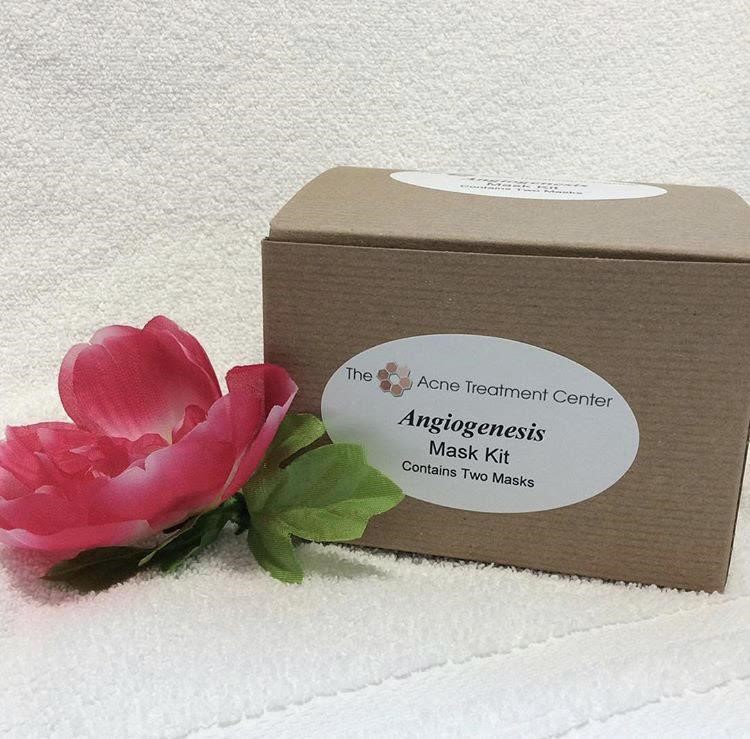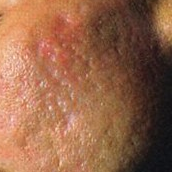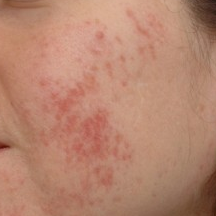Over the years The Acne Treatment Center has received many questions and requests, but none so frequently as when we might introduce masks that our clients can use at home. There has also been a great deal of interest in natural, plant-based formulas. Therefore, we are excited to introduce a collection of herbal masks for home use. Each mask will be discussed in depth in a series of articles posted here on our website. Today we present in-depth information about our angiogenesis mask.
Written by Jasmine Cohen, BA, LME, BCE
ANGIOGENESIS MASK KIT

Do you find that you have dark marks or discoloration left over from previous acne lesions that just don’t seem to go away? You might be tempted to call this discoloration “acne scarring” because a few months have passed and those marks are still visible. Well, I’m here to tell you some good news because we now have an herbal mask that may be able to help!
Those marks you might refer to as acne scars are actually something else entirely. We call it angiogenesis, and it is a term referring to those pesky, red and purple marks that remain under the skin long after the acne itself is gone. When the skin incurs a wound like a pimple, the body develops a network of blood vessels beneath the wound to deliver nutrients and oxygen that help the lesion heal. Once the wound has resolved, that network of blood vessels needs to get reabsorbed by the body which takes approximately 6 to 8 months to occur. For some of us unlucky ones that period can stretch out to a year. During that time span, you will notice the dark reddish-purple marks gradually fade.
True acne scars tend to be more difficult to remedy and are distinguished by textural inconsistencies such as deeply pitted areas or an undulating appearance to the skin. Angiogenesis, on the other hand, is only a temporary discoloration and the marks tend to be flat rather than textured as seen in the two contrasting images below.

Acne Scars 
Angiogenesis
Fortunately, there are specific herbs and plant components that seem to expedite the skin’s recovery time allowing these red marks to heal more quickly, and we have compiled our top wound healing herbs in an easy-to-use masking kit that you can enjoy in the convenience of your own home.
The Angiogenesis Mask Kit includes the following ingredients and supplies for two mask applications:
- Herbal blend of powdered Rose Hips, Yarrow Flower, Nettle Leaf, Licorice Root & Hibiscus Flower
- Two mixing bowls
- A spatula
- Aloe-Moisturizer mixer
Each herb included in our blend of ingredients contains beneficial components like antioxidants, vitamins, and minerals that have a desired effect on the skin. In our Angiogenesis Mask, the herbal components work together to help alleviate redness & irritation, expedite the wound healing process and reabsorption of blood underneath the skin; plus it enhances moisturizing capabilities to improve the skin’s barrier function.
For more detailed information on how the individual ingredients will affect your skin, keep reading!
ROSE HIPS POWDER

Rose Hip is a powerhouse anti-inflammatory herb, bursting with vitamins and antioxidants like Vitamin C. Did you know rose hips contain 60 times more Vitamin C than that of an orange? Rose Hips also contain Vitamin E, Lycopene, and Beta-Carotene. Let’s go into what these individual components do for the skin.
Vitamin C is an antioxidant that neutralizes damaging free radicals and aids in the skin’s natural regeneration process by repairing damaged skin cells. It also stimulates the production of collagen and elastin that are responsible for keeping the skin firm and plump. Additionally, it is a two-fold brightening agent that inhibits the skin’s melanin production to help prevent hyperpigmentation while also fading the dark marks that currently exist.
Vitamin E is an antioxidant similar to Vitamin C – and they both perform better when paired together! Antioxidants help combat free radicals by not only reducing oxidative damage, but also by playing a role in increasing cell restoration and repairing damaged skin such as scars and burns. Furthermore, Vitamin E provides moisturizing benefits that strengthens the skin barrier function to aid in the healing process.
Lycopene is yet another antioxidant – it is often found in red and pink fruits and vegetables most notably in tomatoes. Lycopene specifically helps in preventing skin discoloration, textural changes, and fine lines and wrinkles. It also calms the body’s inflammatory response reducing redness and irritation.
Beta-Carotene is an antioxidant that lends the bright orange and red pigment to fruits and vegetables while also providing protection against UV damage. When beta-carotene is applied topically to the skin, it gets converted into retinyl esters – a precursor to vitamin A. Vitamin A has long been lauded as an anti-aging adjunct for its collagen producing capabilities, as well as exfoliating properties that help even out skin tone related to hyperpigmentation.
YARROW FLOWER

Yarrow flower is a plant that in Greek mythology was used by the legendary hero Achilles to heal his battle wounds. It has been referred to as the “master of the blood” as it regulates the flow of blood in multiple ways. First, it can moderate the blood flow to and from the skin, and in and out of capillaries. It has the ability to thicken the blood to reduce hemorrhaging or thin the blood in the event of a blood clot. It plays a role in wound healing as it contains styptic compounds to slow or stop bleeding. It also stimulates fibroblasts which accelerates skin connective tissue to close the wound and speed up healing. Additionally, it is antimicrobial, antibacterial, and acts as a pain reliever. It is rich in antioxidants and anti-inflammatory compounds that can help reduce redness and irritation. The anti-inflammatory phytochemicals in yarrow include carotenoids, flavonoids and terpenes.
Carotenoids are plant pigments responsible for the vibrant yellow, orange, and red colors in plants. Yarrow flowers vary in color from white to red, pink, and yellow. Carotenoids exhibit antioxidant properties that protect against UV radiation, and improve the tone, brightness, and firmness of the skin.
Flavonoids like carotenoids, are similarly acknowledged for the vivid colors found in plants. Their antioxidant properties help absorb and protect against UV radiation and modulate signaling pathways that positively influence cellular function.
Terpenes are aromatic compounds in plants often used in essential oils that have anti-inflammatory, antibacterial, and antimicrobial properties.
NETTLE LEAF

Nettle leaf is known to relieve inflammatory skin conditions such as dermatitis, eczema, acne, rosacea and psoriasis. Plus it supports the wound healing processes. It is a rich source of B vitamins and Vitamin K1.
Vitamin B actually encompasses several sub-vitamins in the Vitamin B family that act as coenzymes. The most concentrated B Vitamins in nettle leaf are thiamin, riboflavin, niacin and pyridoxine.
Vitamin B1 (Thiamin) performs an important role in the regeneration of collagen to keep skin supple & strong, while supporting the wound healing process.
Vitamin B2 (Riboflavin) aids in the secretion of mucus that keeps the skin moistened and helps improve conditions like eczema and dermatitis. It also supports the acceleration of wound healing in the skin and is required for normal cell growth and repair.
Vitamin B3 (Niacin or Niacinamide) benefits the skin on multiple levels. It supports proper lipid barrier function by not only boosting ceramide production in order to keep the skin moisturized, but also by regulating sebum production to prevent excess oil from contributing to acne. It reduces inflammation in the skin easing redness and blotchiness in conditions like acne, eczema, rosacea, and dermatitis. Additionally, It has been shown to control melanin production and lighten areas of hyperpigmentation.
Vitamin B6 (Pyridoxine) is a powerful anti-inflammatory. It works well to reduce inflammatory skin conditions and was formerly known as “the anti-dermatitis factor”. It is required for the synthesis of amino acids and DNA and therefore plays a crucial role in cell replication for the skin.Vitamin K is commonly used for dark undereye circles as the nutrient helps rejuvenate the capillaries around the delicate eye area. It can also help relieve bruising by aiding the body in the reabsorption of broken blood vessels underneath the skin to expedite healing. This translates well into reabsorbing the angiogenesis or network of blood vessels underneath healing acne lesions. It is used for skin recovery and seems to help with inflammatory conditions. Surgeons often prescribe a topical Vitamin K cream for use after surgery to support the healing process.
LICORICE ROOT

Licorice root has long been used for its lightening and brightening effect on the skin to even out the skin tone of existing pigmentation. It is rich in what are called tyrosinase-inhibitors helping to prevent future hyperpigmentation from UV exposure and melanin production. It helps to fade the appearance of dark scars. It has also been used to soothe red, irritated skin in the case of acne, eczema, rosacea, and psoriasis from its anti-inflammatory properties. The key compounds in licorice root are glycerrhizic acid, glabridin, and Licochalcone A.
Glycyrrhizic Acid is 50 times sweeter than sugar and gives licorice its distinct flavor. This acid acts as an anti-inflammatory antioxidant that helps to reduce irritation and redness in the skin, such as with acne wounds and bug bites. It can even help calm the itch associated with healing scabs.
Glabridin is a type of phytochemical called a flavonoid that is responsible for the plant’s pigmentary characteristics. In this case glabridin lends a soft yellow hue found in the licorice root. Flavonoids act as antioxidants that help protect the skin by both absorbing UV light and modulating signaling pathways that influence cellular function. Glabridin has also been touted as an effective skin lightener that helps diminish dark marks from scarring or sun damage and prevents future hyperpigmentation as a tyrosinase inhibitor.
Licochalcone A is a phenolic constituent of Licorice root that has anti-inflammatory and anti-microbial effects. It has been shown in studies to alleviate erythema (redness) and irritation in Rosacea skin types as well as from shaving-related irritation.
HIBISCUS FLOWER

Hibiscus flowers are referred to as the “botox plant” because of its ability to diminish fine lines and wrinkles. It contains antioxidant properties that may help slow the aging process and keep the skin looking firmer, plumper and less wrinkled. It brightens the skin tone, reduces hyperpigmentation, and minimizes the appearance of acne scarring and discoloration. Hibiscus flower contains well known and previously discussed antioxidants like Vitamin C & Beta-Carotene. Additionally, it contains lesser known antioxidants called anthocyanin and myricetin which prevent elastin and collagen degradation. As a wound healing agent, hibiscus increases the production of fibronectin that helps the edges of a wound close to speed up healing, and it stimulates the expression of genes involved in various wound healing processes such as skin hydration and regeneration.
Anthocyanin is a powerful antioxidant and flavonoid pigment found in red and blue plants like berries, beets, red cabbage, grapes, and hibiscus flowers. It protects against UV radiation and inhibits elastin degradation. It also combats free radicals and reduces damage to DNA that could otherwise lead to cancer formation. It is interesting to note that anthocyanin is red or pink at a lower pH, but then turns purple or blue as the pH increases and becomes more alkaline. This explains how during the course of masking under an herbal combination with hibiscus powder, the mask may start out bright red or pink and then transition into a deeper purple-blue color as the pH increases over several minutes.
Myricetin is another notable antioxidant and flavonoid with anti-inflammatory and anticancer properties. It exhibits strong anti-photoaging effects meaning it protects against the damage of UV exposure on multiple levels – it absorbs UVB rays and prevents collagen degradation by inhibiting the production of certain aging enzymes that lead to fine lines, wrinkles, and skin cancers. It also boosts the skin regeneration abilities in wound healing.
